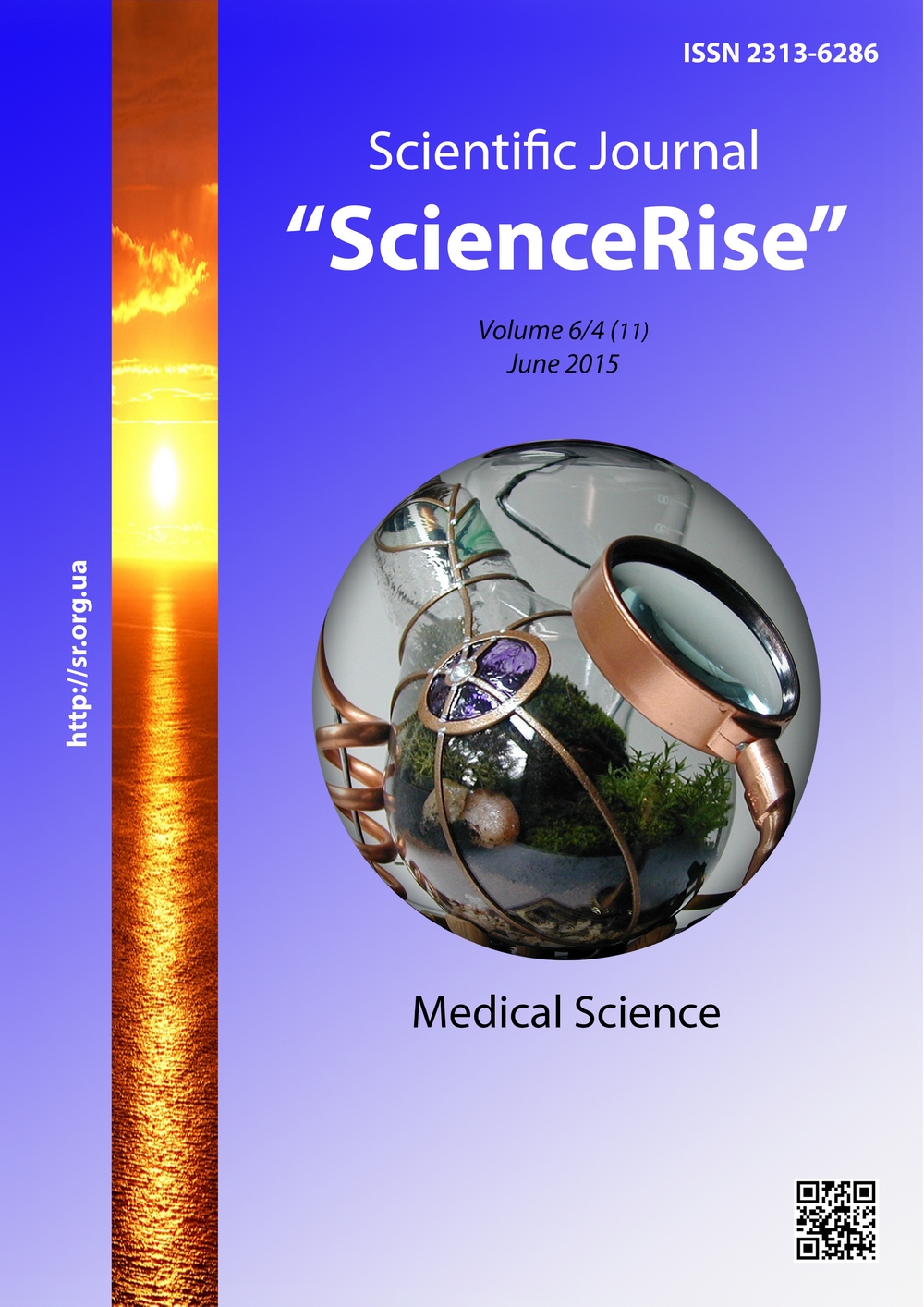Критерии ранней этиологической диагностики серозных менингитов у детей
DOI :
https://doi.org/10.15587/2313-8416.2015.45465Mots-clés :
дети, серозный менингит, энтеровирусы, герпесвирусы, клиника, лабораторная диагностика, диагностические алгоритмыRésumé
У 220 детей с серозным менингитом проанализированы клинико-анамнестические и лабораторные данные. На их основе, используя математический анализ с применением неоднородной последовательной процедуры Вальда-Генкина, разработаны алгоритмы ранней этиологической диагностики. Использование диагностических алгоритмов позволяет с высокой степенью надежности предположить этиологический фактор серозного менингита
Références
Logan, S. A. E., MacMahon, E. (2008). Viral meningitis. BMJ, 336 (7634), 36–40. doi: 10.1136/bmj.39409.673657.ae
Volokha, A. P. (2014). Serozni meninhity u ditey [Serous meningitis in children]. Contemporary pediatrics, 1, 39–41.
Roos, K. L., Greenlee, J. E. (2011). Meningitis and encephalitis. Сontinuum Litelong Learning Neurol, 17 (5), 1010–1023. doi: 10.1212/01.con.0000407057.02414.a9
Symachenko, O. V., Hermanenko, I. G., Lysytskaya, T. I. (2010). Izuchenye klynyko-epydemyolohycheskykh i dyahnostycheskykh markerov menynhyta u detey na sovremennom etape [The study of clinical and epidemiological and diagnostic markers of meningitis in children at the present stage]. Medical panorama, 8, 17–23.
Skachkov, M. V., Denysyuk, N. B. (2011). Klynyko-epydemyolohycheskye aspekty enterovyrusnykh menynhytov u detey [Clinical and epidemiological aspects of enteroviral meningitis in children]. Сhildren infections, 4, 18–21.
Eshmolov, S. N., Sytnykov, I. G., Mel'nykova, I. M. (2012). Klynyko-laboratornye osobennosty enterovyrusnykh menynhytov u detey v sovremennykh usloviyakh [Clinical and laboratory features of enteroviral meningitis in children in modern conditions]. Epidemiology and Infectious Diseases, 3, 38–42.
EL Hiar, R., Haddad, S., Jaïdane, H., Hober, D., Ben M’hadheb-Gharbi, M., Gullberg, M. et. al. (2012). Enteroviral Central Nervous System Infections in Children of the Region of Monastir, Tunisia: Diagnosis, Laboratory Findings of Cerebrospinal Fluid and Clinical Manifestations. Indian Journal of Virology, 23 (3), 294–302. doi: 10.1007/s13337-012-0104-1
Korzhenevich, A. V., Michaylova, E. V., Eremeeva, I. G. (2005). The clinic-laboratory characteristics of children enterovirus meningitis. 4th World Congress of the World Society for Pediatric Infectius Diseases (WSPID), 106.
Dumaidi, K., Frantzidou, F., Papa, A., Diza, E., Antoniadis, A. (2006). Enterovirus meningitis in Greece from 2003-2005: diagnosis, CSF laboratory findings, and clinical manifestations. Journal of Clinical Laboratory Analysis, 20 (5), 177–183. doi: 10.1002/jcla.20129
Symovan'yan, E. N., Bovtalo, L. F., Bovtalo, V. B. (2009). Optymyzatsyya terapyy enterovyrusnoho menynhyta na fone herpetycheskykh infektsyy u detey [Optimization of therapy of enterovirus meningitis on the background of herpes infections in children]. Сhildren infections, 3, 62–67.
Lebedyuk, M. N., Zapol'skyy, M. E. (2011). Herpetycheskoe porazhenye nervnoy systemy [Herpetic lesions of the nervous system]. Ukrainian Journal of Dermatology, Venereology, cosmetology, 2, 92–97.
Szychowska, Z., Kuchar, E., Sasiadek, M. (1996). Herpes simplex meningoencephalitis in an infants observed during an epidemic of enterovial infections of the nervous system. Pediatr. Pol., 71 (8), 721–725.
Zadorozhna, V. I., Bondarenko, V. I., Demchyshyna, I. V. (2008). Otsinka efektyvnosti zastosuvannya virusolohichnoho metodu dlya diahnostyky enterovirusnykh infektsiy [Evaluation of the effectiveness of virological method for the diagnosis of enteroviral infections]. Preventive medicine, 2, 23–28.
Boyko, L. T. (2014). Sovremennye metody laboratornoy dyahnostyky seroznykh menynhytov [Modern methods of laboratory diagnosis of serous meningitis]. Ukrainian Journal psychoneurology, 2 (79), 25–27.
Novyk, E. S., Protasenya, I. I., Molochniy, V. P. (2008). The method of differential diagnosis of meningococcal meningitis and serous enterovirus etiology by studying the status of free liquor in children. Patent of Russian for useful model. 2339039 С1; declared 15.06.07; published 20.11.08.
Khokhlova, Z. A., Konysheva, T. V., Lykova, O. F., Zakharova, E. V. (2008). A method for the differential diagnosis of bacterial and viral meningitis. Patent of Russian for useful model. 2323444; declared 22.05.06; published 27.04.2008.
Alekseeva, L. A., Skrypchenko, N. V., Mazaeva, E. M., Bessonova, T. V., Vyl'nyts, A. A. (2015). A method for the differential diagnosis of meningitis in children. Patent of Russian for useful model. 2 541 150 C1; declared 27.12.13; published 10.02.2015.
Téléchargements
Publié-e
Numéro
Rubrique
Licence
(c) Tous droits réservés Лариса Анатольевна Ходак, Виктория Игоревна Браилко, Татьяна Ивановна Навет, Ольга Васильевна Книженко, Наталья Ивановна Скрипченко 2015

Cette œuvre est sous licence Creative Commons Attribution 4.0 International.
Our journal abides by the Creative Commons CC BY copyright rights and permissions for open access journals.
Authors, who are published in this journal, agree to the following conditions:
1. The authors reserve the right to authorship of the work and pass the first publication right of this work to the journal under the terms of a Creative Commons CC BY, which allows others to freely distribute the published research with the obligatory reference to the authors of the original work and the first publication of the work in this journal.
2. The authors have the right to conclude separate supplement agreements that relate to non-exclusive work distribution in the form in which it has been published by the journal (for example, to upload the work to the online storage of the journal or publish it as part of a monograph), provided that the reference to the first publication of the work in this journal is included.

